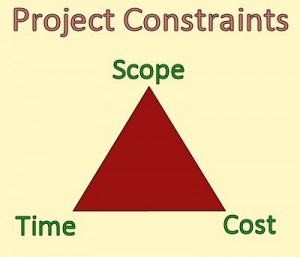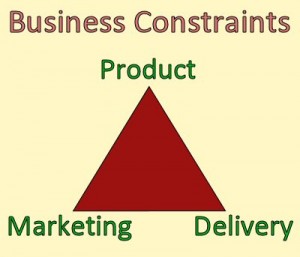Anyone who has been near the project management discipline has heard about the “Project Triangle“. That’s the rule of thumb that essentially says that when you’re building something you can have it good, fast, or cheap–pick any two. You can make a good product quickly, but it won’t be cheap. You can build it good and cheap, but it won’t be done quickly. Or you can build it fast and cheap, but it won’t be very good.
This same concept applies to building a business. Good businesses can be built either fast or cheap, but not both as a general rule. There is the occasional exception–a service business, for example, that has very low overhead and just happens to tap into an unexploited market–but for the most part you’re going to need either a lot of money or a lot of time (and patience) to build a good, solid business.
This same concept of balance can be useful in looking at resource allocation within your business, as well. In this instance we replace the three corners with Product, Marketing, and Delivery:
- Product: The goods or services your business sells, including the people who give the service.
- Marketing: The means by which your business attracts buyers for your goods or services, including the people who seek buyers.
- Delivery: The means by which your business delivers the goods or services to the customer, also known as capacity or infrastructure, and including the people who support the production and marketing of products and services.
In this model you have capital to invest into your business. While you can invest in just one corner of the triangle, such expansion in that direction will often require expansion in one of the other two corners as well. For example, expanding your company’s ability to deliver goods or services will only be effective by itself in the long term if that particular corner is currently lagging behind the other two. Expanding delivery by itself generally results in a lot of unused capacity unless the demand for the product also increases.
Similarly, you can invest in acquiring more inventory or developing more service offerings, but without increasing the demand your services will go unused and your added inventory will gather dust. Or you could invest in marketing, but run into trouble when you have neither the supply to satisfy the demand nor the capacity that deliver the increased demand.
You may be able to focus on just one corner of the business for awhile without touching the others, but eventually it will catch up with you. You could increase marketing, resulting in a higher demand. You may be able to meet that demand by letting stock levels get low, or by getting your service providers to work harder, but eventually both will hit the wall, unable to give any more. Without some follow-up effort to bolster one or both of the other corners any growth will be short-lived.
That is where many businesses get into trouble. They think only about one corner, invest in expanding their business in that direction, and then have no plan or no resources (or both) to implement to shore up the other corner(s). If you have $10,000 to invest, and you invest it all in marketing, what will you do if you are suddenly selling through your inventory much faster while your collections are lagging farther behind, resulting in a negative cash flow? Sure, it’s a nice problem to have, but you’ve likely just swapped one problem for another just as bad, if not worse.
What to do about it? I’ll offer some ideas next time.
What do you think of this model? Leave a comment! I doubt I’m the first to think of this. If you’ve seen this somewhere before, also drop me a comment to say where.



Pingback: The fine art of resource allocation : ThomStratton.com